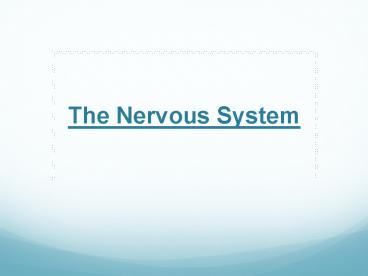The Nervous System PowerPoint PPT Presentation
Title: The Nervous System
1
The Nervous System
2
Nervous System
- We have now seen how muscle contraction/movement
occurs and how the body creates energy to sustain
movement. But what initiates the movement? - The Nervous system is the bodys system which is
responsible for gathering information, storing
it, and responding to it. Its main objective is
gather internal and external information, analyze
that information and initiate certain responses
to satisfy certain needs.
3
Pass it on..
- 2 teams, everyone holds hands
- Last person of each team holds a stop watch
- When I say GO I will send out a signal to each
team, it will travel around the circle and once
it reaches the last person you must stop the stop
watch - Switch up the last person of each team
4
(No Transcript)
5
(No Transcript)
6
Nervous System
- Central Nervous System (CNS) consists of the
brain and spinal cord ONLY - Peripheral Nervous System (PNS) consists of all
nervous tissue outside of the CNS. Includes
nerves that communicate with muscles. - Spinal nerves- 31 pairs (innervate muscles of
body) - Cranial nerves- 12 pairs (innervate muscles of
face)
7
(No Transcript)
8
Cranium and Vertebral Column
- Cranium contains the brain
- Vertebral column contains the spinal cord
Therefore, the cranium and vertebral column house
the contents of the CNS.
9
(No Transcript)
10
The Brain
- Cerebral cortex is the outermost layers of cells
that contain the nucleus (of the neuronal cells)
and hence appear dark (grey matter). Cortex (grey
matter) and medulla (white matter) are terms used
to denote the outer and inner or central part of
an organ.
11
The Brain has 6 parts
- Cerebrum
- Cerebellum
- Brain Stem
- Diencephalon
- Limbic System
- Reticular activating system
- See text for functions!
12
Cerebrum
- Largest part of the brain
- Controls sensory and motor activities as well as
intelligence - Cerebrum can be divided down the middle into two
halves called the cerebral hemispheres, which
have nerve fibres that connect them to one
another. - Each hemisphere is divided into sections or
Lobes named after the cranial bones that lie
over that region.
13
Cerebral hemispheres are divided into lobes
Frontal lobe higher order thought, and
initiation of movement Parietal lobe
somatosensation (pain, temperature, and touch
sensation from the body) Temporal lobe
processes auditory, olfactory (smell), and
gustatory (taste) information Occipital lobe
processes visual information Cerebellum refines
and coordinates movement
14
CerebellumThe Second largest part of the brain!
- Lies behind and below the cerebrum
- Main function is to co-ordinate muscle movement
and control balance
15
The Brain Stem
- Located below the cerebrum and in front of the
cerebellum - Links the cerebrum with the spinal cord
- Responsible for autonomic functions, posture,
muscle tone, and eye movement
16
The Diencephalon
- Consists of the Thalamus and the Hypothalamus
- Located b/w the cerebrum and the brain stem
(basically the middle of the brain) - Thalamus relays sensory info
- Hypothalamus controls things such as body
temperature, appetite, emotions and other
autonomic functions
17
Other components
- The Limbic system is a collection of nerve
structures within the cerebral hemispheres
(cerebrum) - responsible for regulating emotions, and hunger
- The reticular activating system is located
throughout the cerebral cortex. - Responsible for sending sensory information to
the appropriate centres for interpretation. Also
it is crucial for maintaining consciousness.
18
Spinal Cord
19
Spinal Cord Dorsal View
20
(No Transcript)
21
(No Transcript)
22
When Things go wrong!
23
(No Transcript)
24
Innervate entire body
Innervate entire face
25
(No Transcript)
26
Sympathetic Nervous System
27
(No Transcript)
28
Parasympathetic Nervous System
29
(No Transcript)
30
Spinal Cord Injury
- SCI refers to traumatic injury of the spinal cord
(motor vehicle accident, fractured vertebrae) - Symptoms vary greatly depending on where the
spinal cord is damaged - 2 types of SCI
- Quadriplegia- loss of motor and sensory functions
in all four limbs due to injury of cervical
region of spinal cord. - Paraplegia- loss of motor and sensory functions
of lower extremities (thighs and legs) only, due
to damage of spinal cord below the cervical level.
31
Spinal Cord Injury
Injury above this level results in quadriplegia
Injury below this level results in paraplegia
32
Rick Hanson Man in Motion
- Turn your books to page 98.

